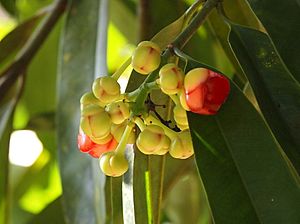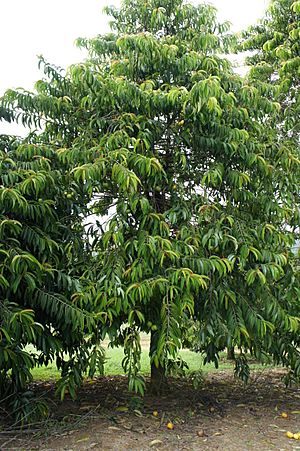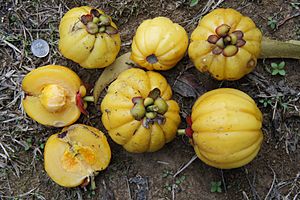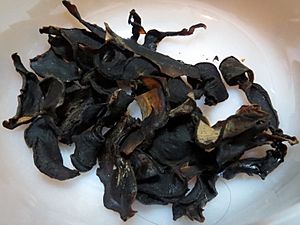Garcinia atroviridis facts for kids
Quick facts for kids Garcinia atroviridis |
|
|---|---|
 |
|
| Flowering Garcinia atroviridis | |
| Scientific classification | |
| Genus: |
Garcinia
|
| Species: |
atroviridis
|
Garcinia atroviridis, often called asam gelugur or asam keping, is a large tree that grows in the rainforests of Peninsular Malaysia and Sumatra. This tree grows naturally all over Peninsular Malaysia. People also plant it a lot, especially in the northern parts, because its fruit is useful for cooking and for health. Garcinia atroviridis is a plant that lives for many years. You can often find it in the green forests of southern Thailand and Malaysia.
What Does the Asam Gelugur Tree Look Like?
The asam gelugur tree can grow very tall, sometimes over 20 meters (about 65 feet)! It has a long main stem, smooth gray bark, and branches that hang down. The leaves are dark green and shiny. They are long and narrow with a pointy tip and edges that curl up a bit.
The flowers of this tree are a dark red color. The round fruits grow one by one at the ends of the small branches. Each fruit is about 7–10 centimeters (about 3–4 inches) wide. When the fruits are ripe, they turn a bright orange-yellow color. These ripe fruits are often cut into slices and dried. People use them in curries or cook them with lots of sugar to eat as a sweet treat.
How Do People Use Asam Gelugur?
The fruit of the asam gelugur tree has many natural acids, like citric acid and malic acid. These are the same kinds of acids found in lemons and apples, which make them taste sour. It also contains other helpful natural compounds.
When the asam fruit is ripe, it is a bright yellow-orange color. People often slice these fruits and dry them in the sun. These dried slices are known as "asam keping." You can buy them in stores. They are very popular to use in vegetable salads because they are extremely sour. The dried fruit slices are also cooked and used as a common ingredient in many Asian dishes, especially in curries and soups.
Asam gelugur is a fruit tree that grows year after year. It is native to the warm, tropical weather in Malaysia. You can also find these trees in other parts of Southeast Asia, especially in Thailand. In Thailand, more and more people want to buy and use the asam fruit.




